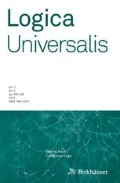Abstract
We present a number of equivalent calculi for many-valued logics and prove soundness and strong completeness theorems. The calculi are obtained from the truth tables of the logic under consideration in a straightforward manner and there is a natural duality among these calculi. We also prove the cut elimination theorems for the sequent-like systems.

Similar content being viewed by others
Notes
We use the term “\(\varvec{L}\)-sequent” to distinguish between sequents from [2] and “just” sequents in our calculi.
The value \(v(\varphi )\) of a formula \(\varphi \) under a valuation v is defined by a standard recursion from the truth tables.
This semantics is common to all calculi under consideration and will be referred to as just \({\varvec{MVL}}\) semantics.
Here the subscript “A” stands for the axiom description of \({\varvec{MVL}}\).
In fact, the natural deduction for \(\varvec{L}\) also interprets in \(\varvec{MVL}_{\varvec{A}}\) (and all other calculi considered in this paper) in the following manner: a set of formulas \(X_n\) is derivable from \(X_1 \, | \, \cdots \, | \, X_{n-1}\) in the former if and only if the sequent \(\bigcup \nolimits _{k=1}^{n-1} X_k \times \{ k \} \rightarrow X_n \times \{ n \}\), where \(X_k \times \{ k \} = \{ (\varphi ,k), \varphi \in X_k \}\), is derivable in the latter.
We say that a labelled formula \((\varphi ,k)\) is a subformula of a labelled formula \((\varphi ^\prime , k^\prime )\), if \(\varphi \) is a subformula of \(\varphi ^\prime \).
In other words, v satisfies a sequent \(\Gamma \rightarrow \Delta \), if the metavalue of the classical metasequent \(\{ v(\varphi ) = v_k : (\varphi ,k) \in \Gamma \} \rightarrow \{ v(\varphi ) = v_k : (\varphi ,k) \in \Delta \}\) is “true.”
In other words, \(\varvec{\Gamma }\) is complete, cf. [8, paragraph 3.63] and the definition of the “classical” negation completeness.
This theorem provides us with an alternative proof of (weak) decidability of \(\varvec{MVL}_{\varvec{A}}\), cf. the note following Theorem 3.11.
Note that \(*(\varphi _1,\ldots ,\varphi _\ell )\) may be introduced into the succeedent, only.
Note that \(s\) depends both on \(*\) and k.
Note the form of \(\Theta _q\): for each \(j = 1,\ldots ,\ell \) it contains exactly one labelled formula with the first component \(\varphi _j\).
Since \(k^\prime \not \in K\) and \(k^\prime \ne k^{\prime \prime }\), \(k^\prime \not \in K \cup \{ k^{\prime \prime } \}\). Thus, \(K \cup \{ k^{\prime \prime } \} \ne \{ 1,\ldots , n\}\).
Note that \(k^\prime \notin K\).
Recall that we are in the case of (5.21) with \(K \cup \{ k^\prime \} = \{1,\ldots ,n \}\).
Namely, if \(\Theta = \{ (\varphi _1,k_1),\dots ,(\varphi _\ell ,k_\ell ) \}\), then k is such that \(*(v_{k_1},\ldots ,v_{k_\ell }) = v_k\).
Cf. the definition on the top of p. 66 in [10].
That is, \(\{ \Theta _1,\ldots ,\Theta _{s} \} = (*(\varphi _1,\ldots ,\varphi _\ell ),k)^{-1}\).
This is a generalization of general elimination rules to multi-valued logics, cf. [4].
References
Avron, A., Zamansky, A.: Non-deterministic multi-valued logics–a tutorial. In: Proceedings of the 40th IEEE International Symposium on Multiple-Valued Logic, ISMVL. IEEE Computer Society, pp. 53–60 (2010)
Baaz, M., Fermüller, C. G., Zach, R.: Systematic construction of natural deduction systems for many-valued logics. In: Proceedings of the 23rd IEEE International Symposium on Multiple-Valued Logic, ISMVL, IEEE Computer Society, pp. 208–213 (1993)
Baaz, M., Lahav, O., Zamansky, A.: Finite-valued semantics for canonical labelled calculi. J. Autom. Reason. 51, 401–430 (2013)
Francez, N.: Harmony in multiple-conclusion natural-deduction. Log Univ 8, 215–259 (2014)
Francez, N., Kaminski, M.: On poly-logistic natural deduction for finitely-valued propositional logics. J. Appl. Log. 6, 255–289 (2019)
Gentzen, G.: Untersuchungen über das logische Schliessen I. Math. Z. 39, 176–210 (1935a)
Gentzen, G.: Untersuchungen über das logische Schliessen II. Math. Z. 39, 405–431 (1935b)
Hanazawa, M., Takano, M.: On intuitionistic many-valued logics. J. Math. Soc. Jpn. 38, 409–419 (1986)
Kaminski, M.: Nonstandard connectives of intuitionistic propositional logic. Notre Dame J. Form. Log. 29, 309–331 (1988)
Mendelson, E.: Introduction to Mathematical Logic. CRC Press, Boca Raton (2010)
Roussenau, G.: Sequents in many-valued logic I. Fundam. Math. 60, 23–33 (1967)
Roussenau, G.: Correction to the paper “sequents in many-valued logic I”. Fundam. Math. 60, 313 (1968)
Roussenau, G.: Sequents in many-valued logic II. Fundam. Math. 67, 125–131 (1970)
Sheffer, H.M.: A set of five independent postulates for Boolean algebras, with application to logical constants. Trans. Am. Math. Soc. 14, 481–488 (1913)
Takahashi, M.: Many-valued logics of extended Gentzen style I. Sci. Rep. Tokyo Kyoiku Daigaku, Sect. A 9, 271–292 (1968)
Takahashi, M.: Many-valued logics of extended Gentzen style II. J. Symbol. Log. 35, 493–528 (1970)
Author information
Authors and Affiliations
Corresponding author
Additional information
Publisher's Note
Springer Nature remains neutral with regard to jurisdictional claims in published maps and institutional affiliations.
Rights and permissions
About this article
Cite this article
Kaminski, M., Francez, N. Calculi for Many-Valued Logics. Log. Univers. 15, 193–226 (2021). https://doi.org/10.1007/s11787-021-00274-5
Received:
Accepted:
Published:
Issue Date:
DOI: https://doi.org/10.1007/s11787-021-00274-5




